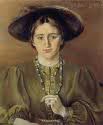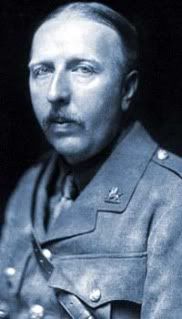 |
| Mrs Ford- |
 |
| Violet Hunt-role model for Sylvia |
Parade's End is Ford Madox Ford's (FMF) WWI tetralogy set in England and France in the period of around 1914 to 1918. It was published as four parts but should be viewed (as FMF certainly did) as a unified work. I have already
posted on the four individual works, Some Do Not, No More Parades, A Man Could Stand Up, and The Last Post. Each of the participants in the Read A Long, Dwight, Nicole, and Hannah have also done multiple posts on the work which have helped me understand the book a lot. Dwight has an excellent resources page for those interested in more background information on FMF.
 |
| About 40 while in the Army |
Parade's End is a not just a great novel, it is a great work of art. It is very carefully constructed, what seem like errors or lapses by the narrator (not everyone agrees with this) and characters are part of the structure of the work. Parts of the work read like a play of the period, parts are brilliant explorations of the streams of consciousness of very diverse persons. It is also, in its central character Christopher Tietjens, a superb portrait of a man deeply into the reading life. It experiments with numerous writing styles. While our lead character is in the trenches in France in WWI we can feel the extreme discordance in the consciousness of Tietjens reflected in the strident prose of the work. When some of the more vapid characters in the book converse over silly self-centered matters the prose seems like that of an Edwardian play. Throughout the work there are 100s of marvelous epigrams and pronouncements on history, marriage, art, literature and the 18th century that alone made the book worth reading for me.
As I was reading this I somehow had a flashback to a class on early modern art that I took many years ago. One of the themes of Parade's End is the nature of knowledge, memory, and the construction of history. In a way, Parade's End, like The Wave by Virginia Woolf which I am now reading, is almost doing in a novel what the Cubists tried to do in their movement (time frame 1907 to 1921.) This quote from Wikipedia is very useful:
In cubist artworks, objects are broken up, analyzed, and re-assembled in an abstracted form—instead of depicting objects from one viewpoint, the artist depicts the subject from a multitude of viewpoints to represent the subject in a greater context. Often the surfaces intersect at seemingly random angles, removing a coherent sense of depth. The background and object planes interpenetrate one another to create the shallow ambiguous space, one of cubism's distinct characteristics.
This is very much what FMF is doing in Parade's End. I would alter the quotation to say social reality and maybe all reality comes from the point at which the most points of view intersect. (In this I see it as similar to Woolf's The Waves published in 1930.) Part of the point of the massive number of cultural references is to suggest that culture increases our ability to depict internally a rich universe and from that internal projection we enrich the collective socially constructive aspects of reality.
Parade's End is a super rich book with many themes. It is a great portrait of a marriage which seems to make little sense until we think about it a bit then we realize there is much more to the marriage of Sylvia and Christopher than meets the eye. It is a great story of a culture in massive transition. It is not an encyclopedic narrative as I once thought it might be and in fact in the heart of its meaning it seems to undercut the very notion of such a possibility.
I tremendously enjoyed Parade's End. A lot can be learned just from unraveling the references and allusions in the work. (That is one of many ways the Internet has enriched our ability to read. For example, I thought a literary reference made by Tietjens as from a Russian novel was really from Henry James and with the Internet I found I was correct in very short period of time. In the pre-Internet days I would have just had an uneasy feeling about the passage.)
With a brief internet search you will see that FMF was a very controversial figure and was greatly disliked by many who knew him well. Jean Rhys (with whom he had a romance) wrote a novel in which FMF is one of the central characters. He is depicted as a predatory man who preys on women whom he sees as having as their place to serve his genius. FMF did have about 30 relationships with women in the arts and literature (many of these women ended up hating him but, like Sylvia for Christopher, did not want to let another woman take their place). FMF was incredibly well read. I have on order his 800 plus page work The March of Literature and am very much looking forward to learning from FMF. FMF helped many people like Joyce, Pound, Lawrence, Rhys, and Hemingway become writers and is now probably less known or read than any of them. I also think there may be a backlash of sorts against Ford now in some circles due to the perception that he had a predatory attitude toward women.
Parade's End is a not a work we can lollipop our way through (Ok, I like the Edwardian slang I learned from the book). It sets a standard few books can match. I really do not think there are ten books written in the 20 century more worth reading than Parade's End.
I think there are a few others now reading Parade's End and I am very much looking forward to their posts.
Mel u





1 comment:
Wow. I took the last dozen pages with me last night to a fundraiser we attended and, while not trying to be antisocial, whenever alone for a minute I'd read a little more until I finished.
To change the subject, Ford could not have known it at the time that he was positioning Christopher and Sylvia to withstand the upcoming world-wide depression.
As low as The Last Post is regarded by some (moreso in comparison to the previous books), it made me respect the previous three volumes that much more (by showing how things could have gone wrong in them) as well as drawing the mealsack of a work to a close in a satisfying close (without providing complete resolution).
Post a Comment